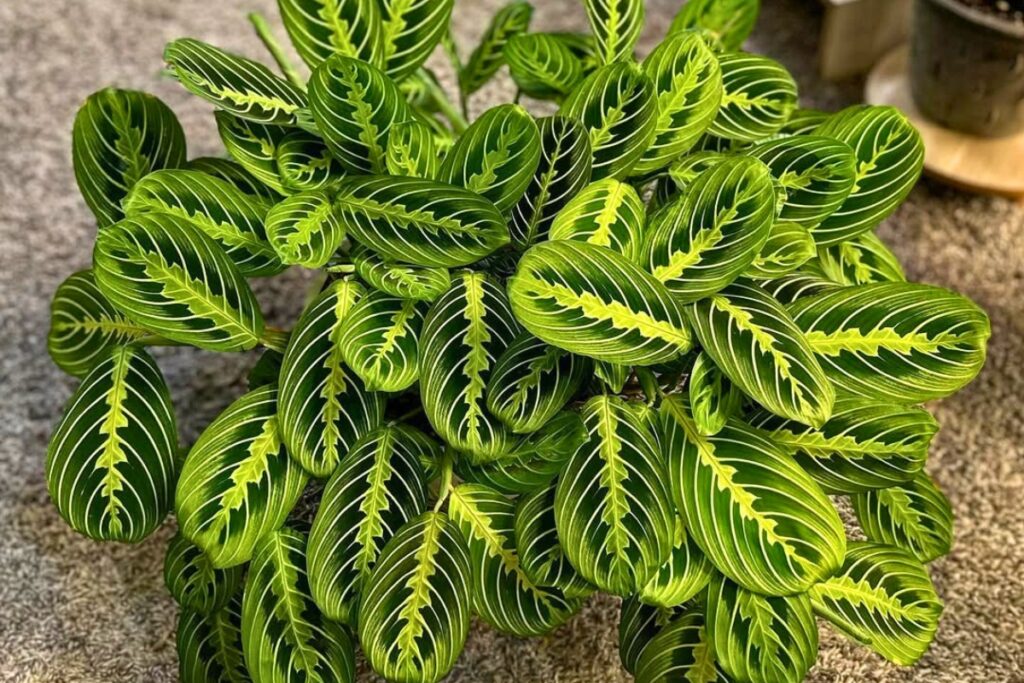If you’ve recently brought home a Prayer Plant, you’ll quickly discover why it’s both rewarding and slightly challenging to grow. These tropical beauties, known for their striking foliage and unique leaf movements, require specific care to truly flourish indoors. While they’re not the most demanding houseplants, understanding their key needs can mean the difference between vibrant, upright leaves and a drooping, lackluster specimen. Let’s explore exactly what your Prayer Plant needs to thrive in your space.

Contents
Light Requirements and Placement for Prayer Plants
Although prayer plants can tolerate low light conditions, they thrive best in bright, indirect sunlight. You’ll want to place your plant 3-5 feet away from east or north-facing windows, where it can receive filtered morning light without harsh afternoon rays.
Don’t place your prayer plant in direct sun, as this will scorch its delicate leaves. If you notice the distinctive red veining starting to fade or the leaves becoming pale, your plant likely needs more light. In rooms with intense sunlight, you can diffuse the light using sheer curtains or window films.
Watch for leaves folding up dramatically during the day, which signals too much direct light exposure.
Humidity and Temperature Control Essentials

Prayer plants need more than just the right lighting to flourish in your home. These tropical beauties thrive in humidity levels between 50-60%, which you’ll need to maintain through regular misting or a humidity tray.
Keep your prayer plant’s environment between 65-80°F (18-27°C), and don’t let temperatures drop below 55°F. You’ll notice the leaves curl and become crispy if the air’s too dry or cold.
To boost humidity, group your prayer plant with other tropical plants, run a humidifier nearby, or place the pot on a pebble tray filled with water. Just make sure the pot’s bottom doesn’t sit directly in water to prevent root rot.
Soil Selection and Watering Best Practices
Since proper soil and watering form the foundation of healthy prayer plants, you’ll need to start with a well-draining potting mix. Combine two parts peat moss, one part perlite, and one part regular potting soil to create the ideal growing medium.
Water your prayer plant when the top inch of soil feels dry to the touch, typically every 5-7 days. Don’t let the soil become waterlogged or completely dry – aim for consistently moist conditions. During watering, pour slowly until you see water flowing from the drainage holes, then empty the catch tray after 15 minutes.
In winter, reduce watering frequency by about 30%, but never let the soil dry completely.
Common Prayer Plant Problems and Solutions
While maintaining a healthy prayer plant can be rewarding, you’ll likely encounter several common growing issues along the way. Brown leaf tips often indicate low humidity or mineral buildup from tap water, while yellowing leaves typically point to overwatering or poor drainage.
If you notice curling leaves, increase humidity by misting daily or using a pebble tray. Crispy edges mean your plant’s getting too much direct sunlight – move it to a shadier spot. For pest problems like spider mites, wipe leaves with neem oil solution every 5-7 days until resolved.
Root rot’s another frequent issue, but you can prevent it by ensuring proper drainage and avoiding waterlogged soil.
Pruning and Propagation Methods
Regular pruning keeps your prayer plant looking its best and promotes healthy growth throughout the year. Remove any yellowed, damaged, or dead leaves by cutting them off at the base with clean, sharp scissors.
To propagate your prayer plant, you’ll need stem cuttings with at least two nodes. Make cuts just below the nodes, remove lower leaves, and place stems in water or moist potting mix. For water propagation, change the water every 5-7 days until roots develop, typically within 2-3 weeks.
When roots reach 2-3 inches long, transplant your cuttings into small pots with well-draining soil, maintaining high humidity as they establish themselves.
